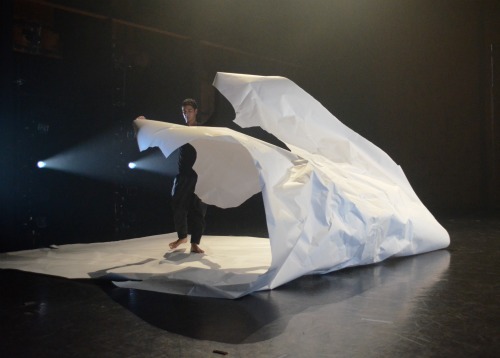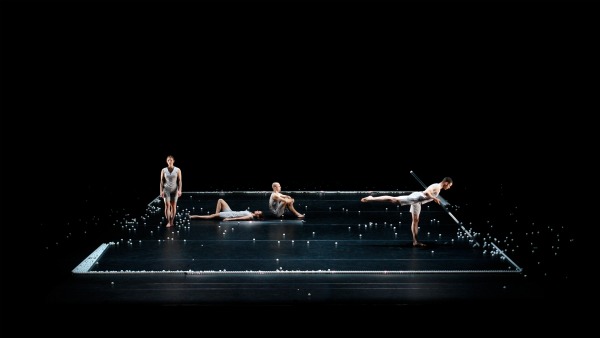Is Jonah Bokaer 30 yet? During the silent beginning of his solo Recess, a woman in the audience of Jacob’s Pillow’s Doris Duke Studio Theater whispered to her companion “he’s so young!” He may look like a tall, self-possessed boy, but he has accomplished as much or more than many 40-year-old performer-choreographers. He spent eight years dancing in Merce Cunningham’s company; picked up a degree in Visual and Media Studies; spearheaded the establishment of the innovative organization and venue Chez Bushwick: founded the Center for Performance research; choreographed a series of extremely intriguing pieces, often involving computerized effects; toured abroad; danced in works by colleagues; and provided choreography for at least four of Robert Wilson’s opera productions.
All the dances of Bokaer that I’ve seen have been precise, elegantly designed, and economical. Each one seems complete in itself—needing neither more nor less than it has. Collaborators assist him in creating visual structures both actual and virtual. Neither of his two U.S. premieres, Recess and Why Patterns, make use of technology (beyond Aaron Copp’s coolly beautiful lighting), although the computer program Dance Forms figured in the creation of the first version of the latter. In both works, however, the choreography meshes intimately with—and is in part determined by—sculptural objects. The gravity of the performers renders the flashes of wit all the more sly.
There is no sound score for Recess, and the only thing on stage apart from Bokaer is a long roll of the white paper used to back photo shoots. The wooden barn wall of the theater is exposed. This time, the visual design is by Daniel Arsham, an artist who makes architecture and sculptural shapes change in intriguing and unsettling ways. Bokaer unrolls the paper across the stage, prodding it with a beautifully arched foot and making a quarter turn with each advancing step. Throughout the piece, he utilizes a select palette of movements and poses. He stands erect, arms at his sides; walks forward and backward; changes directions; drops to one knee; slides backward on his belly; and, when he first reaches stage left, raises himself into a push-up position above the white avenue he has created.
That last-mentioned act engenders the first startling image. Beneath him, his black shadow appears. Where did it come from? Did I not notice it before? Before long, it turns out not to be a shadow, but a hole, and Bokaer propels himself backward beneath the paper, gathering it around himself and then stepping out of it. His behavior is that of a builder—thoughtful, considering his moves—as if he’s been given the makings of a giant origami and no prescribed pattern to follow.
Picking up a corner, he creates a fold, then another, stepping on it or pressing it with his hand to create a crease. Then he starts over, with a new idea for redesigning the space. The paper comes apart at the hole. When he carries half of it to one side of the stage and drops it, it develops a creative mind of its own and starts rhythmically clenching itself into a rocky shape. We laugh in surprise and delight; someone has crept underneath the object. It’s Arsham, but so adroitly managed is the business of shaping and animating the paper that we don’t see him enter or leave.
By the time the piece is over, the paper has morphed into two big white rocks and one smaller one. Bokaer backs away into dimness at the rear of the stage, contemplating the zen garden he has by chance cultivated.
I like the fact that the stage crew arranges the set for Why Patterns before we leave for intermission (to the enigmatic but encouraging sound of “Sex Machine”). A large rectangular playing field, bordered in what appear to be square-edged white tubes fastened together, awaits its occupants. This design by Snarkitecture (Alex Mustonen and Arsham) is not just an arena; it’s a player.
The dance takes its inspiration and its name from the spare, luminous 1978 composition by Morton Feldman that accompanies the piece, along with an almost equally minimal commissioned score by ARP/Alexis Georgopoulos. Why Patterns. No question mark. A statement about the whyness of patterns—none of which, according to Feldman, needs to be more important or more fixed than any other.
Tall Irina Misirlic enters and begins backing away from us. Miracle number one: she steps over the back row of tubes without looking behind her or down. Invisible hands toss a ping-pong ball onto the stage. This may resonate with people who remember that a thrown tennis ball presaged the entrance of Vaslav Nijinsky in his 1912 Jeux, but no such sporty ménage à trois blossoms here.
As we may already have guessed, white ping-pong balls fill the transparent border tubes. And as the four dancers (Adam H. Weinert, James McGinn, and CC Chang, and Misirlic arrange themselves in relation to the tubes and fill the space with lines made by walking backward or forward, their environment begins to change. They have to cope with a universe of more and more wayward balls (Tossed by invisible goblins? A function of climate change?), and patterns develop out of necessity.
At first, only a few balls appear. The dancers scoop them while on the move and slip them to one another. They pick up tubes and empty their contents. Suddenly, a coup de théâtre! A hailstorm storm of balls pelts down at the back of the stage (10,000, I learn). At a later point, some of the little white spheres descend in a slim, one-by-one waterfall . Amid the pause-filled music, the sounds of celluloid bouncing off the floor create an unpredictable counterpoint (and an obstacle-strewn dancing ground).
In addition to gathering the balls to the edges of the space or, eventually, throwing them wildly offstage as fast as they can, the dancers make patterns and play games—walking say, head pressed against a partner’s head, with a ball between them. Balls rebound after dropping; humans don’t. Misirlic keeps the two men busy by falling straight backward in unpredictable directions and trusting them to catch her.
In the end, a single ball is tossed onto the now empty stage. Corny, maybe, but how else would you end this smart piece? Bokaer provokes thought as well as laughter. How many distractions can one cope with? When is a pattern not a pattern? Will the meteor showers we see on a summer night ever come closer to planet earth?



For YEARS props and sets were considered merely for theatre or musical theatre, unheard of for pure dance. Now we have amazing minds not only using sets and props while and with dance, but dancing and creating the sets and props as they go. It is a brain tease to think about the empty stage the work started with when you have such investment in the process of the end environment. It makes me think about the art and movement of swinging a hammer and landing it square on my thumb.